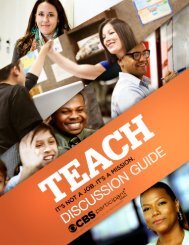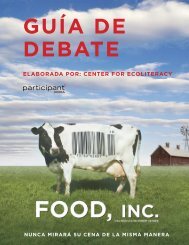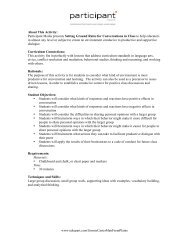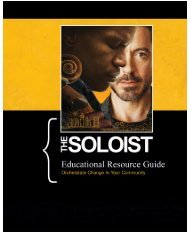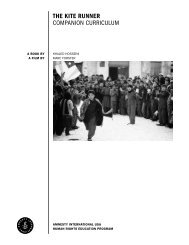Food Inc. Discussion - TakePart
Food Inc. Discussion - TakePart
Food Inc. Discussion - TakePart
You also want an ePaper? Increase the reach of your titles
YUMPU automatically turns print PDFs into web optimized ePapers that Google loves.
In this factory farming model, a single corporation may own or control all aspects<br />
of the chicken production process, from animal rearing and feed production to<br />
slaughter, packaging, and distribution. A corporation may also contract farmers<br />
in an arrangement where the corporation determines all aspects of raising the<br />
animals, while the farmer is responsible for the capital expenditures, the waste<br />
disposal, and much of the risk.<br />
As the film depicts, the transition to factory farming took place partly in response<br />
to our society’s move to fast food. As people came to expect food that was<br />
inexpensive and unvarying in quality and taste, the food industry looked for<br />
ways to produce the food as efficiently and uniformly as possible. Unfortunately,<br />
while industrially produced food appears inexpensive, the price we pay at the<br />
cash register doesn’t reflect its true cost. Factory farming creates a tremendous<br />
amount of water and air pollution, can be detrimental to public health, and relies<br />
on government subsidies—all costs our society bears.<br />
Factory farming also clearly affects the animals. In the factory farm, the animal<br />
is considered a unit of production rather than a living creature, and efficiency<br />
and earnings often outweigh animal health and welfare. People have differing<br />
views on how much comfort and freedom farm animals deserve. Some would say<br />
that to keep food inexpensive, animals should be raised in the most efficient and<br />
cost-effective way possible. Others would argue that animals should not suffer<br />
needlessly and that they should have a certain level of cleanliness and space.<br />
O P E N E R<br />
Before showing the film chapter, distribute copies of the Lunch Survey student<br />
handout on page 28 to complete. Ask students to share some of the factors they<br />
considered when deciding what to eat for lunch. Ask: If everyone is looking for<br />
similar things in their food—for example, that food be cheap and easy to get—<br />
how might that affect what food is available? In what ways might that affect how<br />
food is grown and produced?<br />
2 4<br />
F o o d , I n c . D I S C U S S I O N G U I D E © P a r t I C I P a N t M E D I a



